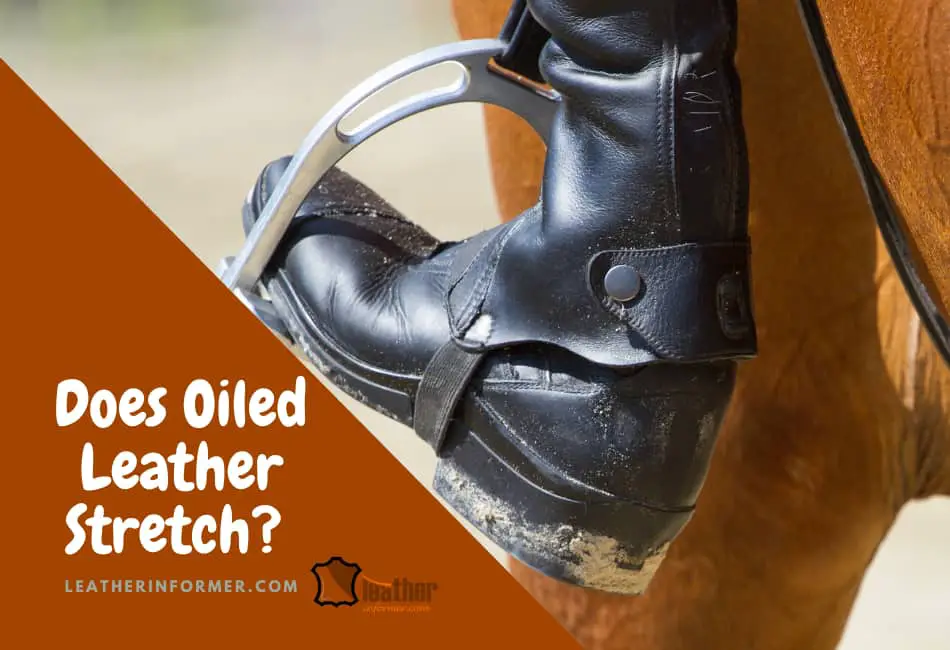Have you ever wondered if your favorite pair of oiled leather boots actually stretch over time, or is it just a persistent myth? As a leather lover myself, I’ve pondered this question while noticing subtle changes in the fit of my well-worn leather jacket.
In this blog post, we’ll unravel the truth behind oiled leather stretching, exploring the factors at play and putting the age-old myth to rest. Get ready for some surprising insights into the world of oiled leather!
What is Oiled Leather?
Oiled leather is a type of leather that has been treated with oils, waxes, and dyes in order to add protection, color, and water resistance.
The most popular oils used for this process are neatsfoot oil, mink oil, and beeswax. Oiling leather makes it softer and more pliable, which is why it’s often used in products such as shoes, boots, bags, and other items that require flexibility.
The Process of Oiling Leather
Oiled leather is created by applying a thin layer of oil to the surface of the leather. The oils penetrate the material, providing waterproofing and protection from physical damage.
The process also gives the leather a slightly darker color and brings out its natural characteristics.
Benefits & Qualities of Oiled Leather
The oiling process leads to an increase in the pliability of the leather, making it softer and more comfortable to wear.
It also adds a layer of protection that makes the leather more resistant to dirt, water, and other elements.
Oiled leather is known for being durable and long-lasting, which makes it a popular choice for leather products.
Does Oiled Leather Stretch?
Now that we know what oiled leather is and how it’s created, let’s address the misconception that oiling leather inherently leads to stretching.
Oiled leather, just like most natural leathers, can stretch. But there are some factors that influence the amount of stretch you’ll experience in your leather items.
Things That Influences The Amount of Stretch in Oiled Leather
While oiled leather can experience some stretching over time, there are several factors that affect its elasticity. Let’s take a closer look at each one.
1. Quality of the Leather
The quality of the leather is one of the most important factors that will determine how much it can stretch. Higher-quality leathers are better suited for stretching than lower-grade ones.
2. Type of Oil Used
Different types of oils can also affect the amount of stretch in leather. Neatsfoot oil, for instance, is known to be softer and more pliable than mink oil or beeswax.
3. Amount of Oil Applied
The amount of oil used during the oiling process also matters. Too much oil can make the leather overly soft and cause it to stretch more than intended.
4. Leather Product Type
The type of leather item you’re using also plays a role in determining how much it will stretch. Shoes, for example, typically require more stretching than bags or wallets as they are often subjected.
5. Conditioning and Maintenance in Leather Stretching
The most important factor to consider when it comes to leather stretching is the level of care and maintenance you provide for your item.
Regularly cleaning and conditioning your oiled leather products can help keep them flexible, as the oils in the leather need to be replenished over time.
6. Age and Wear
Lastly, age and wear also have an impact on the amount of stretch in oiled leather. The more you use your leather product, the more it will naturally stretch due to the oils being absorbed over time.
The Impact of Oiling on Leather Elasticity
To better comprehend the effect of oiling on leather’s ability to stretch, it’s important to note that it doesn’t directly cause significant stretching. However, it can impact the leather’s elasticity in several ways.
Softening the Leather:
Oiled leather has soft fibers, making it more pliable and supple. This softening effect can give the oiled leather a better ability to conform to the shape of the wearer or the objects it holds.
However, it’s important to note that this softening primarily improves comfort and flexibility rather than causing permanent stretching.
Enhancing Natural Stretch
Leather has some natural elasticity. Applying oil to leather can enhance this stretch by reducing friction between the fibers and lubricating them.
This can result in a slight increase in the leather’s ability to stretch, making it more comfortable for the wearer as it can adjust to their movements and contours.
Preventing Overstretching
Oiling leather can both enhance its flexibility and shield it from overstretching. When leather is oiled, it develops a degree of resilience against excessive stretching that is absent in untreated leather.
The oils and waxes used in the oiling procedure keep the leather’s form intact and curtail its capacity to stretch beyond its inherent elasticity.
Conditioning and Maintaining Elasticity
To maintain the elasticity of oiled leather, it is important to condition and maintain it regularly.
This involves applying oil at appropriate intervals to replenish the natural oils that can diminish over time due to wear and exposure.
Proper conditioning is crucial to keep the leather supple and resilient, which helps prevent stretching or sagging.
By taking proactive measures to care for oiled leather, you can ensure that it remains flexible and retains its shape for a long time.
Preserving and Maintaining Oiled Leather
Taking proper care of oiled leather is crucial for preserving its beauty, flexibility, and durability. By following these essential practices, you can maintain the integrity of your oiled leather items and minimize the risk of stretching.
Regular Cleaning
Regularly cleaning your oiled leather items can help keep them looking their best. Make sure to use a soft cloth and warm water with mild soap for best results. Avoid using harsh cleaners or abrasive materials, as these can damage the leather’s surface.
Conditioning:
It is important to condition your oiled leather items regularly to keep them flexible and prevent stretching. By using a conditioning oil, you can replenish the oils that may have been lost due to wear or exposure.
Protection:
To protect your oiled leather against further damage, you should use a protective spray or wax on it. This will help keep it safe from moisture, dirt, and other environmental elements that can cause stretching.
Avoiding Excessive Moisture:
Excessive moisture can cause oiled leather to stretch, so it is important to take precautions against it.
Avoid storing your leather items in damp or humid environments, and always make sure they are completely dry before you put them away.
Proper Storage:
Storing your leather items properly can help minimize the risk of stretching. Keep them in a dry, temperature-controlled environment away from direct sunlight or other sources of heat.
Conclusion
Whether you’re storing, wearing, or caring for oiled leather items, it’s important to be aware of the risks of stretching. Taking proper care of your leather will help retain its shape and prevent excessive stretching.
With regular conditioning, protection, and avoidance of moisture, you can keep your oiled leather items looking their best for years to come.
But, if you’re looking for an even more stretchy leather, you may want to consider synthetic leather or suede instead.
Synthetic leather is known for its flexibility and comfort and can provide a much higher degree of stretch than real leather. However, it generally does not have the same longevity as genuine oiled leather.


